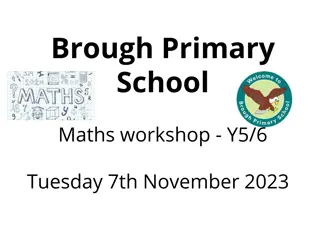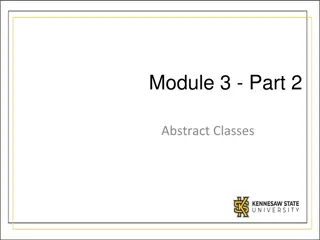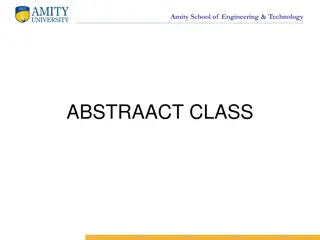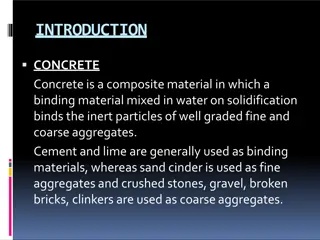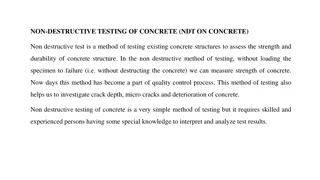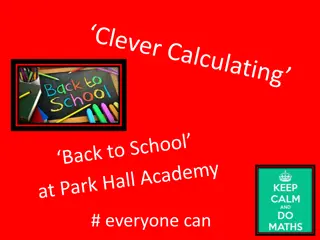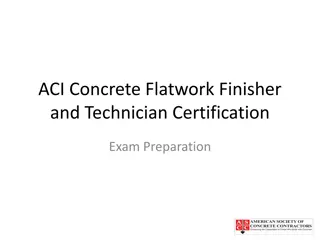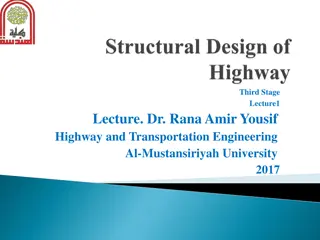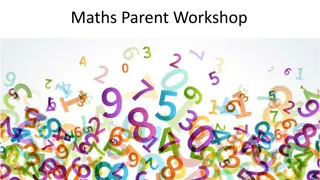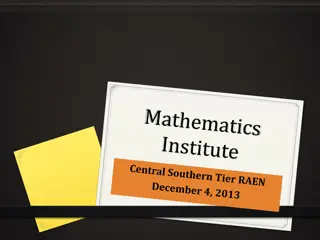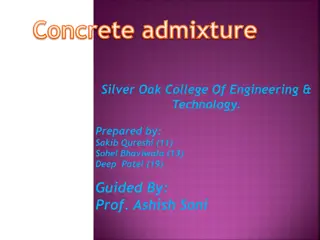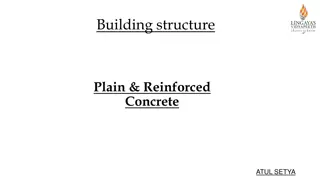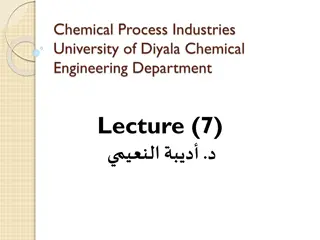Effective Strategies for Teaching Mathematics: Concrete, Pictorial, Abstract Approach
Utilizing concrete manipulatives, pictorial representations, and abstract symbols is a crucial method for enhancing mathematical understanding. This approach guides students from hands-on exploration to visual representation and ultimately to solving problems with symbols. By engaging in this progressive manner, learners grasp mathematical concepts more deeply and foster a real-world connection. Embracing these strategies can greatly support students in comprehending mathematical principles beyond memorization.
Download Presentation

Please find below an Image/Link to download the presentation.
The content on the website is provided AS IS for your information and personal use only. It may not be sold, licensed, or shared on other websites without obtaining consent from the author.If you encounter any issues during the download, it is possible that the publisher has removed the file from their server.
You are allowed to download the files provided on this website for personal or commercial use, subject to the condition that they are used lawfully. All files are the property of their respective owners.
The content on the website is provided AS IS for your information and personal use only. It may not be sold, licensed, or shared on other websites without obtaining consent from the author.
E N D
Presentation Transcript
Contents Manipulatives or Physical Resources Array Base 10 or Dienes Bridging or Crossing 10 Bead Strings Commutative Law or Property Counters Concrete, Pictorial, Abstract Cuisenaire Rods Fluency Number lines and Number Tracks Grouping Inverse Operations Numicon Number Bonds Operations Partitioning (Flexible Partitioning) Place Value Reasoning Ten Frame
Array A set of objects, numbers, pictures, dots or other items that have been ordered into rows and columns. Arrays: help children understand the relationship between repeated addition and multiplication; highlight the inverse , the opposite relationship between multiplication and division; are often introduced when children first learn their 2, 5 and 10 times tables in KS1, and in LKS2 when they learn their 3s, 4s and 8s; help with subitising. Children are encouraged to create arrays when working with manipulatives and when solving problems.
Bridging or Crossing 10 Bridging through 10 is a mental maths strategy used when adding or subtracting two numbers whose total is greater than 10. The same strategy can also be used when bridging through 100, 1000
Commutative Law or Property Commutative relates to the word commute or move around . For addition and multiplication, numbers in a number sentence can be swapped around and the answer will not change. Numbers can be added or multiplied in any order and the answer will not change. 4 x 3 = 3 x 4
Concrete, Pictorial, Abstract (CPA) The concrete, pictorial, abstract approach is an essential strategy for teaching maths. Concrete: using physical objects to solve problems. Pictorial: using drawings to solve problems. Abstract: only using numbers and symbols to solve problems. Children often start learning about a new maths concept by using concrete manipulatives (counters, Base 10, Numicon ). When they are ready they move on to the next step of solving problems using pictures. Once confident, they will solve problems using only numbers or symbols. Manipulating physical resources helps children understand the relationship between numbers and the real world. Introducing maths concepts using concrete resources is a successful teaching strategy regardless of the age or attainment level of the child. It supports children to have a deeper understanding rather than learning methods by rote.
Concrete, Pictorial, Abstract: Example When learning column addition in Year 3, children may start by solving problems using counters or Base 10 (Dienes) and a place value grid. This will support them to understand the concept of exchanging. The resources will be accompanied by pictures of real objects and pictures of maths resources, typically Base Ten followed by place value counters. Finally, the column method will be introduced, initially presented alongside pictures and physical resources. The White Rose worksheets we use for teaching maths follow this strategy. Initial questions often encourage the use of manipulatives, whereas later questions invite children to use abstract methods. Abstract column addition represented alongside pictorial representations of Base 10 and place value counters.
Concrete, Pictorial, Abstract: Worksheet Dienes. Abstract questions using only numbers and symbols. After working with the physical resources and having explored both pictorial and abstract representations, children will work more independently by completing a worksheet. These example questions from a worksheet demonstrate the small steps CPA approach from pictorial to abstract. Place value counters.
Fluency The National Curriculum for maths focuses on three areas: fluency, reasoning and problem solving. Fluency involves developing number sense, understanding place value and the relationship between the four operations, and selecting the most efficient method for solving problems. Fluency means being procedurally and conceptually fluent: children understanding what they are doing and, crucially, why. To become fluent children need 'varied and frequent practice (National Curriculum). Once introduced to a mathematical concept, such as column addition, children practise it until they are confident with the method. Verbal reasoning, explaining their solutions using maths language, and applying their skills to word problems develops fluency in varied contexts. Developing fluency also involves practising basic maths skills, such as rapidly recalling times table facts and number bonds, and using these to make connections: If I know that 4 + 6 = 10, I also know that 14 + 6 = 20 and 140 + 60 = 200. If I understand this, then I can also subtract, or find the difference: the difference between 6 and 10 is 4, 10 6 = 4.
Grouping Grouping is a strategy useful for division. At first, children learn to group pictures and objects into equal groups.
Inverse Operations Addition and subtraction, and, multiplication and division are the inverse of each other. They are opposite operations, one reverses the effect of the other. Children are encouraged to use addition to solve subtraction problems: 14 6 = What could I add to 6 to make 14? Solving division problems is easier if children understand the inverse relationship: 35 5 = What could I multiply by 5 to make 35? Doubling is the inverse of halving. Double 4 is 8; half of 8 is 4. Children can also use their understanding of inverse to check their answers. 394 - 135 = 259 Adding 135 and 259 together would check the answer. Likewise, 432 24 = 18 Multiplying 24 x 18 would check the answer.
Number Bonds Number bonds are pairs of numbers that can be added together to make another number. The simplest example of this is number bonds to 10: 0 + 10 = 10 1 + 9 = 10 2 + 8 = 10 3 + 7 = 10 4 + 6 = 10 5 + 5 = 10 If children have mastered their number bonds to 10, they should easily master number bonds to 20. Number bonds are used when partitioning numbers. Being able to quickly recall number bonds is essential because it helps children calculate using more complicated maths methods, such as long multiplication.
Operations The 4 basic operations are: addition subtraction + - Adding numbers together results in the sum. This is the minus symbol. Also referred to as taking away . multiplication division x Initially, this is taught as repeated addition. Multiplying numbers together results in the product. Sharing into equal groups.
Partitioning (Flexible partitioning) Partitioning involves splitting numbers into smaller parts to make them easier to work with. It is connected to place value. Children learn that 34 is 3 tens and 4 ones, and so can be partitioned into 30 and 4. 34 can also be partitioned in other ways by moving tens and ones between the two parts. 20 + 14 or 10 + 24 Children may use partitioning as the first stages of column addition, subtraction and short multiplication. Partitioning may be represented in the form of a part-whole model. Part-whole model illustrating some of the ways in which 6 can be partitioned.
Place Value Place value is the value of a digit in a number. Children learn about place value by using a place value chart or grid. 324 3 has the value of 300 2 has the value of 2 tens or 20 4 has the value of 4 (4 ones) This number is 23,246. TTH = Ten thousands Th = Thousands H = Hundreds T = Tens O = Ones
Reasoning Reasoning involves logical and critical thinking. Children use these skills to work out the correct strategy to use to solve maths problems. Once children are fluent in a method or with a particular skill, they will use verbal reasoning to explain what they are doing and why, and to select appropriate strategies. The next step is to use their reasoning skills to solve word problems. An example of a reasoning problem from Year 3.
Ten Frame Ten frames are 2 x 5 rectangular frames that help children develop their sense of the number ten. They are a useful visual tool. They are used as images and as a physical resource. Children can place counters or objects within the frame to practise counting, addition and subtraction. A ten frame explaining partitioning.
Manipulatives or Physical Resources
Base 10 or Dienes Base 10 is a tool used by a range of year groups. It is used for teaching place value and the four operations, including the more complex written methods of column addition and subtraction. Children are more easily able to visualise exchanging using this resource. Exchanging ten 10s for 100. This set comprises ten rods, a flat (100), and ones. Working with Dienes to understand division in Year 3.
Bead Strings The beads on a bead string are grouped by colour. Bead strings can consist of 10, 20 or 100 beads. They are used for developing number sense, number bonds, counting, place value, partitioning. This is a 100 bead string. Each group of 10 is easy to identify.
Counters Manipulating counters helps children of all ages develop their understanding of mathematical concepts. Generally, children will use coloured counters that represent any value, two colour counters and place value counters. Children will manipulate physical counters and will see methods represented pictorially using counters. Place value counters are often used on a place value grid/chart.
Cuisenaire Rods Each colour of these proportional sticks represents a different length and the rods can be assigned different values. Children can use them to identify patterns and develop their understanding of the four operations, fractions and proportion. The orange rod has been assigned the value 10. Using proportional rods in other colours, children can learn how the commutative law applies to multiplication. When arranged in a staircase pattern, each rod differs from the next by 1cm.
Number Lines and Number Tracks Children of all ages and abilities work with number lines to develop number sense, to practise counting, to appreciate place value, and to carry out a range of calculations. Number tracks are a first step towards using number lines. Board games are a useful way of practising counting on and back using a number track. Labelled number lines are a useful tool when solving problems using the four operations. In this example, the 7 has been partitioned and the number line provides a useful visualisation of the addition of 2 (or jump ) to the nearest 10, followed by the addition of the remaining 5. In this example, the blank number line provides a visual structure for the counting on method that is being used to find the difference between 35 and 72.
Number Lines and Number Tracks This number line is being used to explain fractions. This one represents an equivalent fraction, decimal and percentage.
Numicon Numicon can be used as an approach to teaching maths, as an intervention strategy and as a useful manipulative. It is multi-sensory and enables children to develop their number sense. The relationships between numbers are easily perceived due to the holes, the colour coding and when combining pieces.



